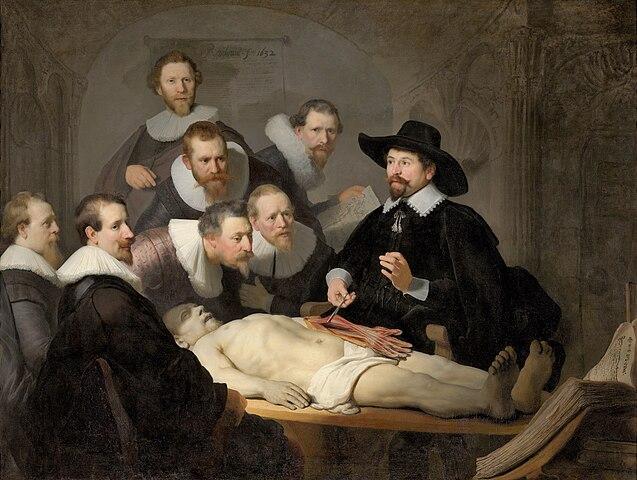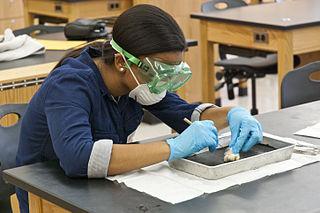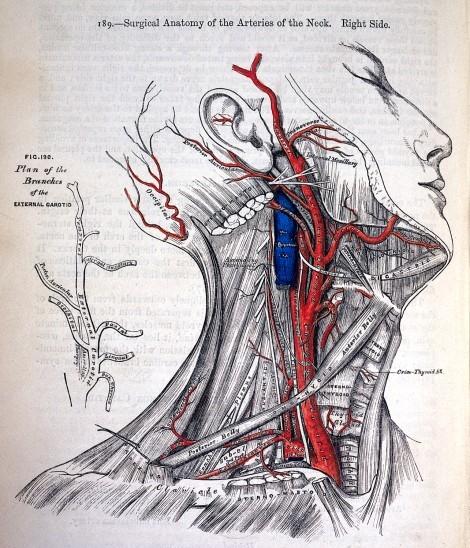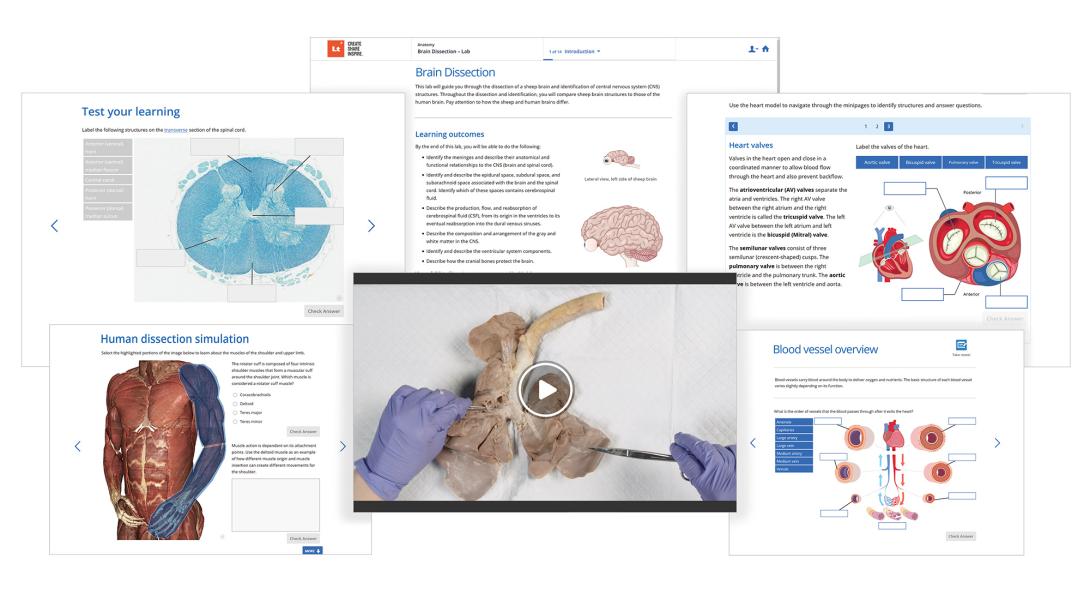The importance and benefits of dissection for undergraduate anatomy classes.
Anatomy is a three-dimensional field. Understanding the relationships between organ systems and related tissues is important for a complete view of that system and the body as a whole.
Historically, dissection gave physicians in training their first view of organs, and their function, in context. Today, we have a huge number of supporting tools and resources to give students that view into the body; but hands-on dissection remains a crucial part of anatomy education.

Dissection for instruction has a long history.
Why is dissection important?
Dissection is categorically different from most teaching methods in anatomy because it is skills-based, and not simply information-based. It is the same as learning to use a microscope or a pipette; supporting information will help you start, but the skills are learned through practice.
In medicine and veterinary sciences, whole body dissections provide the best learning outcomes for students.

Dissection teaches practical skills.
The cadaver is the student’s ‘first patient’, giving them the chance to practice the professional skills they’ll be expected to master before they see their real patients.
They also prepare students for the variability and messiness of real bodies. When a system is cleaned, imaged, and labeled, it’s easy to see what is connected and what is important. A real cadaver is less clearly defined, and will have slight variations in organ placement, number of blood vessels, tissue thicknesses, etc.
Dissection is the transition from the tidy ‘textbook’ anatomy that your students have learned, to the messy ‘real’ anatomy that they will be interacting with in labs or professional practice.
While these practical skills are important, it’s also crucial to take into account the emotional skills that dissection facilitates. Dissection can be a stressful experience for students. It forces them to actively engage with mortality, and to perform actions that would harm the subject if it were still alive. Some students are squeamish about death, and others about having to cut a cadaver. In order to become capable professionals, these students need to build resilience to that squeamishness so that it doesn’t interfere with their work or the outcomes of their living patients.
Time and practice with dissection is a longstanding and effective way of getting students over that emotional hurdle.

Anatomy, whether human or animal, is a content-heavy discipline; but that content is rooted in the physical. Your students can directly interact with the content you’re teaching, and this physical modality helps them to develop physical skills and improves the retention of that information through procedural learning. It is not necessary for all anatomy students, but for those going on to work in laboratories, in medicine, or in veterinary medicine, dissection is a crucial part of learning.
When to use dissection
The cost of sourcing, processing, and housing cadavers is significant and needs to be taken into account when deciding whether to include dissection in a course. Fundamentally, it comes down to the learning outcomes(s) you’re trying to achieve.
If you’re looking to establish a foundational understanding of anatomy, then textbook and computer-assisted learning are more appropriate. For comparative animal biology, for example, it might be more helpful for a student to have access to a computer-assisted learning (CAL) course that allows them to review virtual dissections of different animals than to be dissecting a different animal in each lab without being able to review previous dissections.
If, however, you’re teaching a more advanced course for students who are expecting to move on to laboratory, medical, or veterinary sciences, then dissection is an important tool to include. In this case, a course with hands-on dissection can build on the base knowledge established in earlier CAL-based courses, while still enabling students to develop those necessary physical and emotional skills unique to hands-on dissection.
Given the high cost of dissection, it’s important to take into account when it is most beneficial to students and to ensure its presence in the curriculum at that point.
Supporting dissection with preparatory resources
The better prepared students are ahead of performing dissection, the better their learning outcomes. In a review of anatomy teaching methods, Chumbley, Devaraj, & Mattick (2021) compared dissection, plastic models, plastinated specimens, simulations, virtual dissection tables, and computer-assisted learning in terms of learning outcomes versus dollars spent. CAL provided the most value, with the greatest learning outcomes per dollar, and dissection the least value due to its high financial burden.

By implementing a CAL system in courses leading up to dissection, students build their knowledge of anatomy from cells, to tissues, to organs and organ systems, while also having the flexibility to review how those subjects compare across species. CAL fits within the digital environment students are used to, preparing them with the knowledge they’ll need to get the most from physical dissections.
Related: 10 free high-quality anatomy images for educators to download and use! »
Preparatory resources like lectures, textbooks, recorded dissections, plastinated organs, models, and Computer-Assisted Learning (CAL), are all useful means of building up student knowledge before they are given the opportunity to perform dissections. Allowing students to practice dissection skills, and to develop this knowledge before they are faced with dissections, leads to fewer dissection-related injuries and better learning outcomes.
Related: Check out some of the top features from our Heart Dissection Lab »
Despite the cost associated with dissection, it remains a crucial part of anatomy education. There is no viable replacement for dissection in terms of procedural skills development and preparation for professional practice. However, we can do more to support dissection and ensure students are getting the most out of this expensive educational tool. Building up their knowledge base by covering the ‘textbook’ versions of anatomy first by using computer-assisted learning is the most time- and cost-effective way of achieving positive learning outcomes.
Bring dissection to your students
The Anatomy Collection comes with rich and detailed histology and dissection media for teaching and assessments, including cadaveric dissection images, animal organ dissection videos and images, stylized images, and exploration of anatomical models.
Created in partnership with ToLTech, world leaders in anatomical imagery.
Find out more about the Lt Anatomy Collection »
References
Byrnes, Kevin Gerard, et al. “Communication, Collaboration and Contagion: ‘Virtualisation’ of Anatomy During COVID‐19.” Clinical Anatomy, vol. 34, no. 1, Wiley, Aug. 2020, pp. 82–89. https://doi.org/10.1002/ca.23649.
Chumbley, Samuel D., et al. “An Approach to Economic Evaluation in Undergraduate Anatomy Education.” Anatomical Sciences Education, vol. 14, no. 2, Wiley-Blackwell, Sept. 2020, pp. 171–83. https://doi.org/10.1002/ase.2008.
Chytas, Dimitrios, et al. “Do Virtual Dissection Tables Add Benefit to Cadaver-based Anatomy Education? An Evaluation.” Morphologie, vol. 107, no. 356, Elsevier BV, Mar. 2023, pp. 1–5. https://doi.org/10.1016/j.morpho.2022.01.002.
Ghosh, Sanjib Kumar. “Paying Respect to Human Cadavers: We Owe This to the First Teacher in Anatomy.” Annals of Anatomy-anatomischer Anzeiger, vol. 211, Elsevier BV, May 2017, pp. 129–34. https://doi.org/10.1016/j.aanat.2017.02.004.
Yakura, Tomiko, et al. “The Effect of Simulation‐based Education Before a Cadaver Dissection Course.” Anatomical Sciences Education, vol. 15, no. 2, Wiley-Blackwell, Dec. 2021, pp. 392–402. https://doi.org/10.1002/ase.2124.
Youngblood, Jacob P., et al. “Anatomical Self-efficacy of Undergraduate Students Improves During a Fully Online Biology Course With At-home Dissections.” Advances in Physiology Education, vol. 46, no. 1, American Physical Society, Mar. 2022, pp. 125–39. https://doi.org/10.1152/advan.00139.2021.
